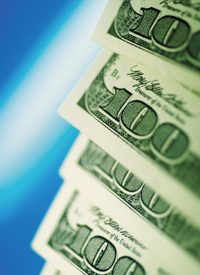
The attack came in the form of an editorial from Xinhua News Agency, one of the dictatorship’s official propaganda arms, following the downgrade of American debt last week by Standard & Poor’s (S&P). It immediately made headlines around the world.
“China, the largest creditor of the world’s sole superpower, has every right now to demand the United States to address its structural debt problems and ensure the safety of China’s dollar assets,” read the commentary. “To cure its addiction to debts, the United States has to reestablish the common sense principle that one should live within its means.”
The stinging Xinhua editorial also proposed “substantial cuts” to America’s “gigantic military expenditure and bloated social welfare costs.” Otherwise, it warned of more credit downgrades and increased financial turmoil to come.
Most alarming to observers, however, was the direct attack against the dollar.
“International supervision over the issue of U.S. dollars should be introduced and a new, stable and secured global reserve currency may also be an option to avert a catastrophe caused by any single country,” the regime said. “All Americans, both beltway politicians and those on Main Street, have to do some serious soul-searching to bring their country back from a potential financial abyss.”
But news of the S&P downgrade led to turmoil in China’s economy as well. Chinese stocks, for example, dropped sharply on Monday. The nation’s controlled currency, however, was allowed to rise significantly against the dollar before dropping back on Tuesday.
Chinese people also expressed outrage in recent days that the communist regime had invested so much of its foreign reserves in American debt. Furious bloggers cited by the New York Times complained that the dictatorship was forcing people to live in poverty so it could lend money to out-of-control American politicians.
China is the U.S. government’s largest single creditor, with over $1 trillion in treasuries as well as more than a trillion in other dollar-denominated assets. The U.S. government is officially above $14 trillion in debt, but the real figure including unfunded liabilities is estimated in the tens of trillions — possibly even hundreds of trillions. State and local governments are facing hundreds of trillions in debts and unfunded liabilities, too.
The Chinese regime’s editorial touted the fact that its own credit-rating agency, Dagong Global, downgraded U.S. Treasuries well before S&P. It also lambasted Western commentators for their arrogant response when the Chinese agency announced the downgrade, saying the move by S&P had proven that it was simply telling investors “the ugly truth.”
Dagong boss Guan Jianzhong took the opportunity to go on the attack as well. In comments e-mailed to CNBC, he said the dollar was being “gradually discarded by the world” and that the “process will be irreversible.”
“I think the most pressing issue facing the U.S. at the moment is to reflect on the crisis which happened in relation with the debt ceiling,” Guan told the financial news agency. “They should get a clear understanding that the continuous decline of the debt service capability will inevitably result in the outbreak of a sovereign debt crisis.”
Speculation about the regime’s potential diversification from dollars has also been making headlines for days. “China will be forced to consider other investments for its reserves. U.S. Treasuries aren’t as safe anymore,” director Li Jie of Central University of Finance and Economics’ Reserves Research Institute told Reuters. “There is a class of assets out there that are more risky than AAA, but less risky than AA+. China didn’t consider these investments before, but now it would be forced to do so.”
Another Chinese economist, Ding Yifan of a state-controlled “think tank,” told Reuters that the chances of even more money-printing by the Federal Reserve were rising. As investors move away from dollars assets, he warned, it could leave the American central bank no choice but to buy up U.S. Treasuries, which would “definitely add more uncertainties to the global economy.”
But China’s dictatorship is hardly the only entity talking about getting out of dollars and treasuries. PIMCO, the world’s largest bond fund, dumped its treasuries earlier this year.
“In addition to an existing nearly US$10 trillion of outstanding Treasury Debt, the U.S. has a near-unfathomable US$66 trillion of future liabilities,” noted PIMCO boss Bill Gross in his August investment outlook, urging investors to consider how the American government would be able to service its obligations. “One rather clever way for the US to pay its bills to foreign creditors is to pay them in depreciated dollars.”
Indeed, former Federal Reserve boss Alan Greenspan recently boasted about the fact that the U.S. government would always be able to pay its bills because the privately owned central bank can just print more money. But rather than calming investors, the statement appears to have made matters worse.
Some analysts even interpreted all of the recent financial turmoil as a challenge to the global fiat-currency system itself. As the dollar continues plunging even against other currencies that are themselves rapidly depreciating, gold — which more than a few investors believe is due for a short-term correction soon — is still surging to record highs. Confusion and panic are growing as investors scramble for safe-haven assets.
The International Monetary Fund recently predicted that China’s economy would surpass America’s by 2016. Despite all of the Chinese regime’s boasting and lecturing, however, countless economists believe that its economy will soon experience a spectacular crash of its own.
With financial chaos reigning from America and Europe to Japan and China, some analysts are forecasting another major economic crisis on the horizon — potentially worse than the most recent recession. Stocks and currencies are still dropping as debt crises around the world dominate the headlines.
Where the global economy might go from here is uncertain. But with the calls for a new world currency growing louder as panic continues to spread, there will likely be a bumpy ride ahead for world markets.



